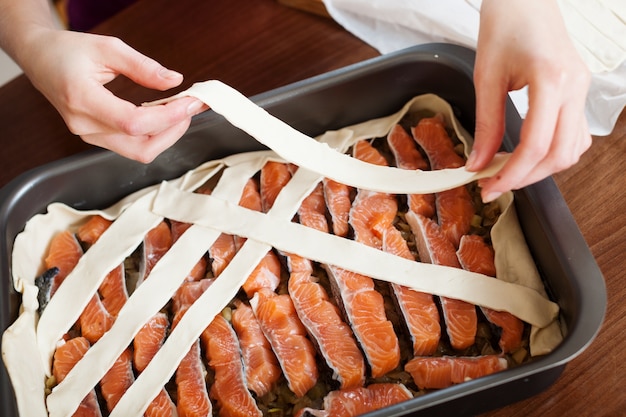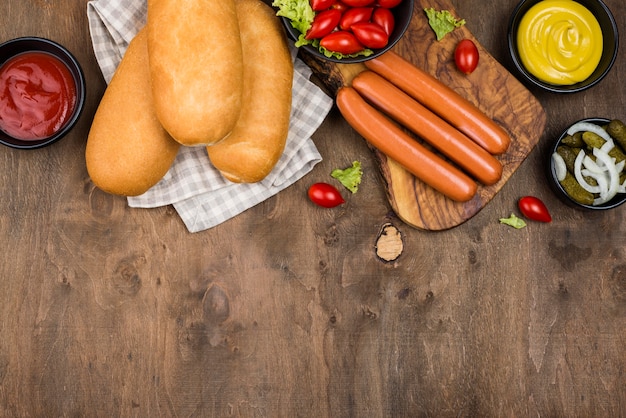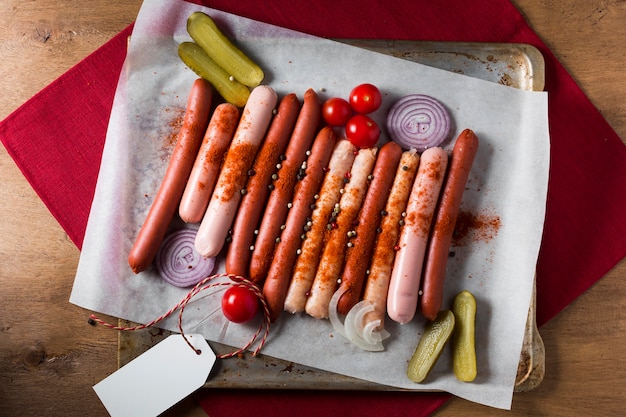Let’s talk about sausage and peppers. It’s a classic for a reason, isn’t it? It’s simple, ridiculously tasty, and perfect for those nights when you're craving a hearty meal but don't want to spend hours slaving over a hot stove. Now, I've been making this dish for years, and I've tried all sorts of variations. I've experimented with different sausages, different peppers, even different herbs and spices. And let me tell you, I've found a recipe that's become my go-to, my absolute favourite. So, gather 'round, folks, and let me share my secrets!
Part 1: The Sausage

The sausage is the star of the show, so we need to choose wisely. I've found that italian sausage works best. It's got a nice flavour and a bit of spice that really brings out the other ingredients. You can use sweet italian sausage, which is milder, or if you're feeling a bit adventurous, try hot italian sausage. Just be warned, it can be quite spicy! I normally go for sweet Italian sausage because it’s a bit milder and works well with the other flavours.
But, hey, if you fancy something different, go for it. There’s no right or wrong here! You could use chorizo, for example, which has a smoky, paprika-infused flavour, or even some good old fashioned Cumberland sausages. Just remember, if you're using a sausage with a strong flavour, you might want to use a milder pepper, or you might end up with a dish that’s a bit too much.
Choosing the Right Sausage
When you're picking your sausages, have a good look at them. You want them to be firm, not too soft or squishy. And make sure they're not too pale. A good sausage will have a nice, deep colour. This indicates that it’s been properly seasoned and hasn’t been sitting around for too long.
How Much Sausage Do I Need?
Well, that depends on how many people you're feeding. I usually use about 1 pound of sausage for a small family. If you're cooking for more people, just adjust the amount accordingly. You can also adjust the amount depending on how much sausage you like! If you’re a real sausage enthusiast, feel free to throw in an extra half-pound.
Part 2: The Peppers

Now, onto the peppers. The classic choice is bell peppers. They come in all sorts of colours – red, yellow, green, orange – and they all add a different flavour to the dish. Personally, I love a mix of colours, it makes the whole thing look more vibrant, right?
The colour of the pepper influences its flavour as well. Red peppers have a slightly sweet flavour, yellow peppers are a bit more mellow, green peppers have a sharper taste, and orange peppers are somewhere in between.
But, again, if you're feeling adventurous, you can use other types of peppers. For example, you could use poblano peppers, which have a slightly smoky flavour, or even some jalape??os if you want to add a kick! Just be careful with the jalape??os, though – they can be really hot!
Choosing the Right Peppers
Like with the sausage, you want to choose peppers that are firm and fresh. Look for peppers that are smooth and have a nice, bright colour. Avoid any peppers that are soft or have any bruises or blemishes. If you see any soft spots or wrinkles, it means they're not as fresh and could have a slightly bitter taste.
How Much Pepper Do I Need?
I usually use 2-3 large bell peppers for a small family. If you're using smaller peppers, you might need more. And, of course, if you're using a different type of pepper, you might need to adjust the amount accordingly. For example, if you’re using jalape??os, a few will do the trick – you don’t want to overdo it!
Part 3: The Onions

Onions are a must for this dish. They add a lovely sweetness and depth of flavour. You can use any type of onion you like – white, yellow, red – it's really up to you. I generally go for white onions because they're a bit milder, but it’s completely your call.
White onions have a sharp, slightly pungent flavour, while yellow onions have a milder, sweeter flavour. Red onions, on the other hand, have a slightly more intense flavour with a hint of sweetness. Choose the onion that best suits your preference.
How Many Onions?
I usually use one medium-sized onion, but you could use two if you really love the flavour of onions. And if you're using smaller onions, you might need to use more than two to get that perfect balance of flavour.
Part 4: The Garlic
Garlic is an essential ingredient in any good Italian dish, and this one is no exception. I find that a couple of cloves of garlic adds a nice kick of flavour without being overpowering.
Chopping the Garlic
You can mince the garlic, or you can chop it into small pieces. I prefer to mince it because it distributes the flavour more evenly throughout the dish. If you chop it into larger pieces, you might end up with chunks of garlic in your dish, which isn’t a bad thing if you love garlic, but it’s not the traditional way.
Part 5: The Herbs and Spices
Now, this is where you can really get creative. There are so many different herbs and spices you can use! For a classic Italian flavour, you can use oregano, basil, and a little bit of thyme. I also love to add a pinch of red pepper flakes for a touch of heat.
If you're feeling adventurous, try adding some rosemary, sage, or even some fennel seeds. The possibilities are endless!
How Much Herbs and Spices?
I generally use about 1 teaspoon of dried oregano and 1 teaspoon of dried basil. But, again, it's all about personal preference. If you love herbs and spices, you can add more! And if you prefer a more subtle flavour, you can use less.
Part 6: The Oil
Olive oil is the best choice for this dish. It adds a lovely flavour and helps to keep the sausages and peppers moist. I normally use extra virgin olive oil because it has a stronger flavour, but you can use any kind of olive oil you like.
How Much Oil?
You don't need much oil – just enough to coat the bottom of your pan. I usually use about 1-2 tablespoons.
Part 7: Putting It All Together
Now, let's get cooking! We're going to start by browning the sausage. Heat your olive oil in a large pan over medium heat and then add your sausages. Cook them until they're browned all over. You can break them up a bit with a wooden spoon if you like. You know, it helps to distribute the flavour throughout the pan, makes it all nice and even.
Once the sausages are browned, remove them from the pan and set them aside. Now, add the onions and peppers to the pan and cook them for about 5-7 minutes, or until they're soft and slightly browned.
While the onions and peppers are cooking, add your garlic and spices to the pan. Stir them in and cook for about 1 minute, or until the garlic is fragrant. Now it's time to add the sausages back to the pan. And then, you can add in your herbs and spices. Stir it all together, and let it all simmer for about 5-10 minutes, until the peppers are cooked through and the flavours have melded.
Serving the Sausage and Peppers
Now, your sausage and peppers are ready! You can serve them on their own, or you can add a side of rice, pasta, or mashed potatoes. It's a perfect dish for a weeknight meal, and it's even better the next day!
Part 8: Variations
Now, as I said, there are loads of ways to make this dish. Here are a few ideas for variations:
- Add Some Tomatoes: Chop up a few tomatoes and add them to the pan with the onions and peppers. They'll add a nice sweetness and acidity to the dish, creating a more complex flavour profile.
- Try Some Mushrooms: Slice up some mushrooms and add them to the pan with the sausages. They’ll add a lovely earthy flavour that complements the sausage and peppers nicely.
- Get Creative with the Herbs and Spices: As I said before, don't be afraid to experiment with different herbs and spices. You can use a mix of fresh and dried herbs, or you can add a pinch of paprika or cumin for an extra kick.
- Add Some Cheese: Sprinkle some Parmesan cheese over the top of your sausage and peppers just before serving. It'll add a nice salty flavour and a bit of richness. Or, for a different twist, try using mozzarella or provolone cheese.
- Make It a One-Pot Wonder: If you're feeling lazy, you can make the whole dish in one pot. Just add all the ingredients to a large pot and cook them over medium heat for about 20 minutes, or until the sausages are cooked through and the peppers are soft. This is a great option for a quick and easy meal.
Part 9: Leftovers
Now, this dish is fantastic as leftovers. You know, the flavours all kind of mingle overnight, and it gets even better! You can reheat it in the microwave, or you can fry it up in a pan. I like to add a splash of water to the pan and then cover it with a lid. This helps to steam the sausage and peppers and makes them nice and juicy.
You can also add your sausage and peppers to other dishes. For example, you could use it as a filling for pasta shells or burritos. Or, you could serve it over rice with a dollop of sour cream or Greek yogurt.
Part 10: Top Tips
Alright, here are a few tips to make your sausage and peppers even better:
- Don't Overcook the Peppers: You want the peppers to be soft but still have a bit of bite. If you overcook them, they'll become mushy and lose their flavour.
- Don't Be Afraid to Add a Little Bit of Water: If the pan starts to dry out, add a splash of water to help keep the sausage and peppers moist. This will prevent them from sticking to the pan and ensure they cook evenly.
- Taste and Adjust: You can always add more herbs, spices, or salt to taste. It’s important to taste the dish as it cooks and adjust the seasoning as needed.
- Use a Good Quality Olive Oil: A good quality olive oil will add a lot of flavour to your dish. Extra virgin olive oil is a good choice for this recipe, as it has a stronger flavour and aroma.
- Don’t Be Afraid to Experiment: The beauty of this dish is that you can experiment with different ingredients and seasonings to create your own unique variation.
Part 11: Sausage and Peppers and Beer
Alright, now we’re talking. What goes best with sausage and peppers? That’s right, a nice cold pint of beer. If you're going for a classic Italian sausage, I recommend a light lager or a pilsner. It's refreshing and won't overpower the flavour of the dish. If you're using a spicier sausage, like chorizo, try a darker beer like a stout or a porter. It'll help to balance out the heat.
If you’re not a beer drinker, try a dry cider or a sparkling water with a squeeze of lemon.
Part 12: Sausage and Peppers and Wine
I know, I know, not everyone is a beer drinker. If you’re more of a wine person, a nice red wine would be lovely with sausage and peppers. A light-bodied red like Pinot Noir or Beaujolais would be a good choice. They won’t overpower the flavours of the dish, and they have a nice acidity that cuts through the richness of the sausage and peppers. If you’re feeling a bit more adventurous, try a Cabernet Sauvignon or a Merlot.
For a lighter option, try a chilled rosé or a crisp white wine like Sauvignon Blanc.
FAQs
1. Can I use ground sausage instead of whole sausages?
Yes, you can! Just be sure to break up the ground sausage well so it browns evenly. It might take a little longer to cook than whole sausages, but it'll still be delicious. You can also add some breadcrumbs to the ground sausage to help it bind together and brown better.
2. Can I make this dish ahead of time?
Yes, absolutely. In fact, this dish is even better the next day! You can make it in advance and then reheat it when you're ready to eat. Just make sure to store it in the fridge in an airtight container. You can even add a splash of water when reheating it to keep it moist.
3. What other vegetables can I add to this dish?
You can add any vegetables you like to this dish! Some other good options include: onions, zucchini, eggplant, mushrooms, spinach, and even potatoes. Just chop them up into bite-sized pieces and add them to the pan with the sausage and peppers. The key is to choose vegetables that cook at a similar rate to the sausage and peppers.
4. Can I freeze sausage and peppers?
Yes, you can freeze it! It's best to freeze it in single servings in freezer-safe bags or containers. To reheat, thaw it overnight in the fridge and then reheat it in the microwave or on the stovetop. You can also reheat it in a skillet with a little bit of olive oil.
5. How do I know if the sausages are cooked through?
The best way to tell if the sausages are cooked through is to use a meat thermometer. The internal temperature should be at least 160°F (71°C). If you don't have a thermometer, you can cut open a sausage and check if the meat is no longer pink and it's cooked through.
And there you have it, folks! My sausage and peppers recipe, guaranteed to satisfy your taste buds and impress your loved ones. Enjoy!
Everyone is watching

Corn on the Cob: The Ultimate Guide to Perfectly Cooked Ears
Healthy MealsAh, corn on the cob. Just the name evokes images of sunny days, barbecues, and that sweet, juicy flavour that ...

Perfect Pork Roast Oven Cooking Time: A Guide to Delicious Results
Healthy MealsThere's something truly satisfying about a perfectly roasted pork. The aroma alone is enough to make your mout...

Ham Cooking Time: How Long to Bake, Smoke, or Boil a Delicious Ham
Healthy MealsAh, ham. It's a classic, isn't it? A real crowd-pleaser, especially around holidays. And when done right, it'...

Scallops: The Ultimate Guide to Perfect Cooking
Healthy MealsAh, scallops. Those delicate, sweet, and utterly delicious morsels of the sea. They hold a special place in my...

Spaghetti Squash: The Ultimate Guide to Cooking and Serving
Healthy MealsRemember that time you saw spaghetti squash at the supermarket, looking all bumpy and strange, and thought, "W...
